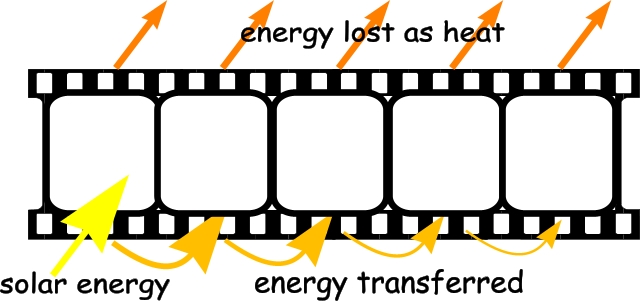Energy from the Sun – Student Investigation
Designed for:
Learning Styles: Independent (student resource), Classroom based
Resource Type: Document, Lesson Plan
Investigation #1 – the Energy Trail

- Have students write the name of one FOOD PRODUCT on a small piece of paper and place all of the pieces of paper into a container.
- Form groups of three (or four). Each group draws one paper out of a box, discusses and decides on the path that the energy from the Sun has taken to finally reside in the food product selected. Not all steps in the template need to be filled but no transformation steps should be skipped. Have on hand a box of extra food sheets from which they can draw another choice should duplication occur (e.g.. “milk” may occur often as a food product)
- Award one point for each energy transformation step correctly shown. Deduct one point for each incorrect step. The team with the most total points wins.
Since many foods have multiple ingredients, it is recommended that students should choose the main ingredient. Some foods have very short energy paths, such as vegetables, whereas others, such as meat are somewhat longer. Students will discover this fact since it is “worth more points”. This is a good introduction to the energy-pyramid in the food chain.
Investigation #2 – Sunlight to Food: How do plants do this?
All green plants contain chlorophyll that absorbs sunlight. The chlorophyll is in small bodies called chloroplasts. The solar energy absorbed by the chlorophyll is used by the plant to activate a process called photosynthesis.
Photosynthesis is a process whereby the plant uses water and carbon dioxide to create compounds called carbohydrates.

Fruit bearing plants such as the tomato store carbohydrates in the fleshy part of the fruit as well as in all other parts of the plant.
- Divide the class into small groups.
- Provide each group with a potted green plant, a sheet of aluminum foil, scissors and several paperclips.
- Students cut pieces of aluminum foil large enough to cover several leaves on their plant.
- Students attach the pieces of foil to leaves on their plant using the paperclips.
- Students label their plants and place them in classroom windows where they will receive plenty of light.
- After a week, students remove the pieces of aluminum foil and compare the appearance of the two groups of leaves.
- Propose an explanation for the changes they have observed.
Discuss the significance of the presence or absence of green pigmentation in the plant leaves.
Energy from the Sun - Student Investigations